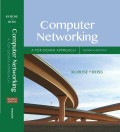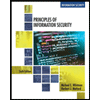
EBK COMPUTER NETWORKING
7th Edition
ISBN: 8220102955479
Author: Ross
Publisher: PEARSON
expand_more
expand_more
format_list_bulleted
Question
Chapter 4, Problem P21P
Program Plan Intro
Internet Protocol (IP):
Internet protocol is a process or protocol in which data is transferred between the computer systems through internet. Each computer system has its own IP address to send or receive the required data.
Datagram:
- In networking, a datagram is a transferring unit which is used to transfer the data from a source to the destination and it doesn’t provide guaranteed service.
- It includes fragmentation process which is defined as the division of the data packet into small one when the data packets are larger than the maximum length of a particular system.
Expert Solution & Answer
Want to see the full answer?
Check out a sample textbook solution
Students have asked these similar questions
Consider the figure below with hosts A to F, and interfaces assigned IP and MAC addresses. Suppose all of the ARP
tables are up to date and Host A sends a datagram to Host F. Give the source and destination MAC and IP addresses
in the frame encapsulating this IP datagram as the frame is transmitted (i) from A to the left router, (ii) from the left
router to the right router, and (iii) from the right router to F.
E
192.168.1.001
00-00-00-00-00-00
192.168.2.001
44-44-44-44-44-44
192.168.3.001
77-77-77-77-77-77
Router 1
192.168.1.002
192.168.2.002
192.168.2.003
22-22-22-22-22-22 33-33-33-33-33-33
55-55-55-55-55
192.168.2.004
192.168.1.003
D
66-66-66-66-66
11-11-11-11-11-11
from A to Router 1
Router 1 to Router 2
LAN
B
Source MAC
address
Destination
MAC address
Source IP
Destination
IP
LAN
Router 2
LAN
192.168.3.002
88-88-88-88-88-88
F
from Router 2 to F
192.168.3.003
99-99-99-99-99-99
Host A and B are communicating over a TCP connection, and Host B has
already received all bytes up through byte 100 (including Byte 100) from A. Suppose
Host A then sends two packets to Host B back-to-back. The first and second packets
contain 40 and 80 bytes of data, respectively. Host B sends an acknowledgment
whenever it receives a packet from Host A.
a. What is the sequence number of the first packet sent from Host A to Host B? What is
the sequence number of the second packet sent from Host A to Host B?
b. If the second packet arrives before the first packet, in the acknowledgment of the
first arriving packet, what is the acknowledgment number? .
A simple CIDR routing table is shown in Figure 1. For each of the destination IP addresses below, indicate which entry in the table it matches. Indicating none if no routing entry can be matched (hint: given an IP packet, the router will check whether there is a routing entry which can be used to route this packet, by checking the destination IP address in the packet with each routing entry: based on the subnet mask of each routing entry, it can extract the network ID and compare it with each routing entry; if there are a few routing entries which can match, the entry with the longest subnet mask wins).
Address Mask
Output Port
10.19.0.0/16
1
10.19.128/17
2
10.19.192/18
3
10.19.192/19
4
0.0.0.0/1
5
141.219.2.10
10.10.10.10
10.19.86.141
10.19.193.6
10.19.255.86
10.19.192.18
Chapter 4 Solutions
EBK COMPUTER NETWORKING
Ch. 4 - Lets review some of the terminology used in this...Ch. 4 - Prob. R2RQCh. 4 - Prob. R3RQCh. 4 - Prob. R4RQCh. 4 - Prob. R5RQCh. 4 - Prob. R6RQCh. 4 - Prob. R7RQCh. 4 - Prob. R8RQCh. 4 - Prob. R9RQCh. 4 - Prob. R10RQ
Ch. 4 - Prob. R11RQCh. 4 - Prob. R12RQCh. 4 - Prob. R13RQCh. 4 - Prob. R14RQCh. 4 - Prob. R15RQCh. 4 - Prob. R16RQCh. 4 - Prob. R17RQCh. 4 - Prob. R18RQCh. 4 - Prob. R19RQCh. 4 - Prob. R20RQCh. 4 - Prob. R21RQCh. 4 - Prob. R22RQCh. 4 - Prob. R23RQCh. 4 - Prob. R24RQCh. 4 - Prob. R25RQCh. 4 - Prob. R26RQCh. 4 - Prob. R27RQCh. 4 - Prob. R28RQCh. 4 - Prob. R29RQCh. 4 - Prob. R30RQCh. 4 - Prob. R31RQCh. 4 - Prob. R32RQCh. 4 - Prob. R33RQCh. 4 - Prob. R34RQCh. 4 - Prob. R35RQCh. 4 - Prob. P1PCh. 4 - Prob. P2PCh. 4 - Prob. P3PCh. 4 - Consider a datagram network using 32-bit host...Ch. 4 - Consider a datagram network using 8-bit host...Ch. 4 - Consider a datagram network using 8-bit host...Ch. 4 - Prob. P8PCh. 4 - Prob. P9PCh. 4 - Prob. P10PCh. 4 - Prob. P11PCh. 4 - Prob. P12PCh. 4 - Consider sending a 2400-byte datagram into a link...Ch. 4 - Prob. P15PCh. 4 - Prob. P16PCh. 4 - Prob. P17PCh. 4 - Prob. P18PCh. 4 - Prob. P19PCh. 4 - Prob. P20PCh. 4 - Prob. P21PCh. 4 - Prob. P22P
Knowledge Booster
Similar questions
- Host A and B are communicating over a TCP connection, and Host B has already received from A all bytes up through byte 126. Suppose Host A then sends two segments to Host B backto-back. The first and second segments contain 80 and 40 bytes of data, respectively. In the first segment, the sequence number is 127, the source port number is 302, and the destination port number is 80. Host B sends an acknowledgment whenever it receives a segment from Host A. d. Suppose the two segments sent by A arrive in order at B. The first acknowledgment is lost and the second acknowledgment arrives after the first timeout interval. Draw a timing diagram, showing these segments and all other segments and acknowledgments sent. (Assume there is no additional packet loss.) For each segment in your figure, provide the sequence number and the number of bytes of data; for each acknowledgment that you add, provide the acknowledgment number.arrow_forwardHost A and B are communicating over a TCP connection, and Host B has already received from A all bytes up through byte 126. Suppose Host A then sends two segments to Host B backto-back. The first and second segments contain 80 and 40 bytes of data, respectively. In the first segment, the sequence number is 127, the source port number is 302, and the destination port number is 80. Host B sends an acknowledgment whenever it receives a segment from Host A.a. In the second segment sent from Host A to B, what are the sequence number, source port number, and destination port number?b. If the first segment arrives before the second segment, in the acknowledgment of the first arriving segment, what is the acknowledgment number, the source port number, and the destination port number?c. If the second segment arrives before the first segment, in the acknowledgment of the first arriving segment, what is the acknowledgment number?d. Suppose the two segments sent by A arrive in order at B. The…arrow_forwardConsider sending a 3500-byte datagram that has arrived at a router R₁ that needs to be sent over a link that has an MTU size of 1000 bytes to R2. Then it has to traverse a link with an MTU of 600 bytes. Let the identification number of the original datagram be 465. How many fragments are delivered at the destination? Show the parameters associated with each of these fragments.arrow_forward
- Host A and B are communicating over a TCP connection, and Host B has already received from A all bytes up through byte 126. Suppose Host A then sends two segments to Host B back-to-back. The first and second segments contain 80 and 40 bytes of data, respectively. In the first segment, the sequence number is 127, the source port number is 302, and the destination port number is 80. Host B sends an acknowledgment whenever it receives a segment from Host A. a. In the second segment sent from Host A to B, what are the sequence number, source port number, and destination port number? b. If the first segment arrives before the second segment, in the acknowledgment of the first arriving segment, what is the acknowledgment number, the source port number, and the destination port number? c. If the second segment arrives before the first segment, in the acknowledgment of the first arriving segment, what is the acknowledgment number? d. Suppose the two segments sent by A arrive in order at B. The…arrow_forwardHost A and B are communicating over a TCP connection. Host B has already received from Host A all bytes up through byte 23. Suppose Host A then sends two segments to Host B back-to-back. The first and the second segments contain 30 and 50 bytes of data, respectively. In the first segment, the sequence number is 24, the source port number is 3000, and the destination port number is 80. Host B sends an acknowledgment whenever it receives a segment from Host A. A. In the second segment sent from Host A to B, what arethe sequence number_________,source port number __________,and destination port number__________?B. If the second segment arrives after the first segment, in the acknowledgment of the second segment, what arethe acknowledgment number___________,the source port number__________,and the destination port number __________?C. If the second segment arrives before the first segment, in the acknowledgment of the first arriving segment,what is the acknowledgment number ___________?D.…arrow_forwardSuppose Host A sends two consecutive TCP segments to Host B over a TCP connection. The sequence number of the first segment is 748, and the sequence number of the second one is 995. Determine the size of the payload carried by the first segment. Suppose that the first segment is lost but the second segment arrives at host B. What will be the acknowledgment number of the acknowledgment segment that Host B sends to Host A?arrow_forward
- Consider the scenario in which a packet is sent from a source host to a destination host along a path that has been predetermined. Create a list of the delay components and include it in the end-to-end delay. Which of the delays is set in stone, and which ones are subject to change?arrow_forwardA connection between two hosts is capable of carrying several packets at the same time. I would appreciate it if you could provide a schedule that details all of the activities that need to be completed in order to finish one shipment. Is it anticipated that one delay would last for a certain amount of time, whilst the other delay's length may be adjusted according to the circumstances?arrow_forwardConsider the datagrams of each layer in the TCP/IP model, e.g., Frame at the Link Layer, Packet at the Internet Layer. Explain the functioning of the following protocols based on their datagram header fields only. Note: You do not need to describe the header field but based on the header field, explain how the protocol works, e.g., Acknowledgement field in a TCP Header is responsible for providing reliable data transfer and in case of data loss or ACK not received, segment is re-sent. You do not need to consider every field of the headers but wherever there are more than 4 fields, then based on 5 fields, describe its functioning, if less than or equal to 4 fields then consider all the fields. Ethernet Frame 11 Frame IPv4 Packet IPv6 Packet TCP Segment UDP Segment HTTParrow_forward
- Consider two hosts P and Q connected through a router R. The maximum transfer unit (MTU) value of the link between Pand Ris 1500 bytes, and between Rand Qis 820 bytes. A TCP segment of size 1400 bytes was transferred from P to Q through R, with IP identification value as 0x1234. Assume that the IP header size is 20 bytes. Further, the packet is allowed to be fragmented, i.e., Don't Fragment (DF) flag in the IP header is not set by P, Which of the following statements is/are correct? (a) Two fragments are created at R and the IP datagram size carrying the second fragment is 620 bytes. (b) If the second fragment is lost, P is required to resend the whole TCP segment. (c) TCP destination port can be determined by analysing only the second fragment. (d) If the second fragment is lost, R will resend the fragment with the IP identification value 0x1234arrow_forward1. What is the difference between packet fragmentation (i.e., at network layer) and frame frag- mentation (i.e., at link layer) in terms of purpose? 2. Suppose that host A is connected to a router R1, R1 is connected to another router, R2, and R2 is connected to host B. Suppose that a TCP message that contains 800 bytes of data and 20 bytes of TCP header is passed to the IP function at host A for delivery to B. Show the Total length, DF, MF, and Fragment offset fields of the IP header in each packet transmitted over the three links. (Assume that link A-R1 can support a maximum frame size of 1024 bytes including a 14-byte frame header, link R1-R2 can support a maximum frame size of 512 bytes, including an 8-byte frame header, and link R2-B can support a maximum frame size of 432 bytes including a 12-byte frame header.) (*hint: the Fragment offset field is denominated by 8-bytes, not bytes) 3. What is the purpose of the path MTU discovery process (see textbook Figure 5-42) and why does…arrow_forward3. Suppose Host A send two TCP segments back to back to Host B over a TCP connection. The first segment has sequence number 90; the second has sequence number 110. a) How much data is in the first segment? b) Supposed that the first segment is lost but the second segment arrived at Host B. In the acknowledgement that Host B sends to Host A, what will be the acknowledgement number?arrow_forward
arrow_back_ios
SEE MORE QUESTIONS
arrow_forward_ios
Recommended textbooks for you
 A+ Guide To It Technical SupportComputer ScienceISBN:9780357108291Author:ANDREWS, Jean.Publisher:Cengage,
A+ Guide To It Technical SupportComputer ScienceISBN:9780357108291Author:ANDREWS, Jean.Publisher:Cengage, Principles of Information Security (MindTap Cours...Computer ScienceISBN:9781337102063Author:Michael E. Whitman, Herbert J. MattordPublisher:Cengage Learning
Principles of Information Security (MindTap Cours...Computer ScienceISBN:9781337102063Author:Michael E. Whitman, Herbert J. MattordPublisher:Cengage Learning Systems ArchitectureComputer ScienceISBN:9781305080195Author:Stephen D. BurdPublisher:Cengage Learning
Systems ArchitectureComputer ScienceISBN:9781305080195Author:Stephen D. BurdPublisher:Cengage Learning

A+ Guide To It Technical Support
Computer Science
ISBN:9780357108291
Author:ANDREWS, Jean.
Publisher:Cengage,

Principles of Information Security (MindTap Cours...
Computer Science
ISBN:9781337102063
Author:Michael E. Whitman, Herbert J. Mattord
Publisher:Cengage Learning

Systems Architecture
Computer Science
ISBN:9781305080195
Author:Stephen D. Burd
Publisher:Cengage Learning